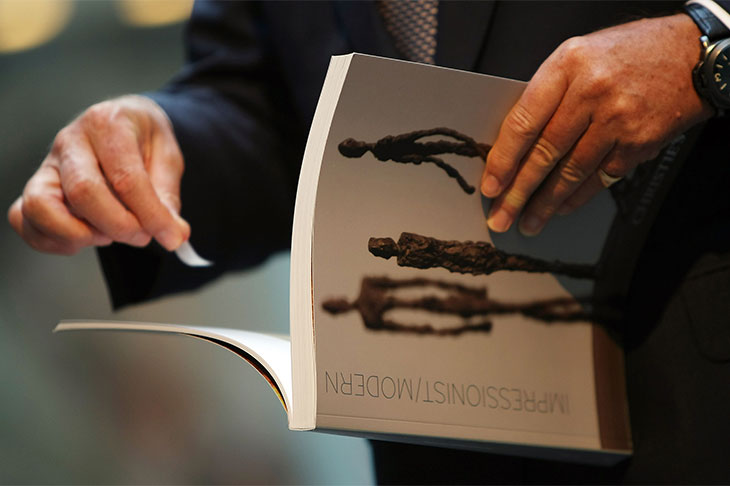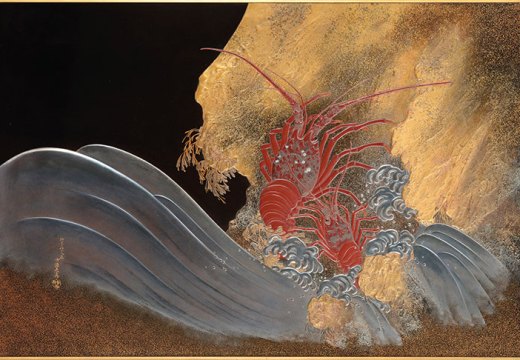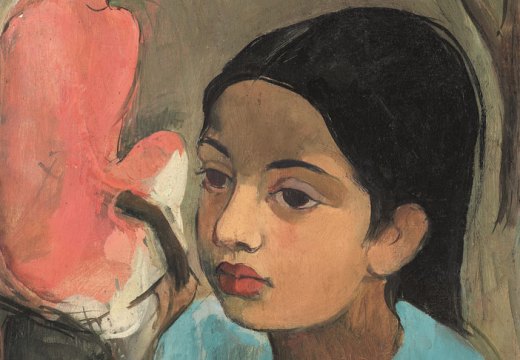‘I’m a traditionalist; I like catalogues. But there’s definitely a force among the younger members of my department who would do away with them all together.’ So says Alex Rotter, Christie’s chairman of post-war and contemporary art, who confesses to happy memories of shelves filled with these ubiquitous auction-house publications. It’s a sentiment many share, and seems to accompany a nostalgia for a pre-internet world when we were afforded uninterrupted time to sit and read in depth.
Such nostalgia is rose-tinted, of course. There were always those who didn’t have the patience or inclination to read a catalogue of essays about paintings and there are many today who will happily turn off their mobile phones and spend time doing exactly that. But it could certainly be argued that the value of the printed catalogue has declined in the 21st century. The numbers bear this out – 10 years ago, Sotheby’s held 310 auctions and printed 2.5 million catalogues; in 2017, those numbers were 334 and 1.1 million respectively.
As an information tool, a catalogue is physically a very unwieldy way to let people know the order of items coming up in any particular sale. The Christie’s catalogue for its Post-War and Contemporary sale in London this October was a full 371 pages for 56 lots (excluding terms and conditions). On top of that, the sheer variety of symbols – which can indicate the relevant taxes that need to be paid on sale or whether a work carries some sort of guarantee – can beg more questions, so that the catalogue has become more confusing than clarifying. (Though admittedly this information is even harder to find online at Christie’s.)
Then there is the catalogue essay. Historically a source of information beyond the facts of sale, the expert essay provides a chance to learn about a work within a broader context, to understand the artist or creator and where the lot’s value really lies. The extended, additional research that can identify a sitter in a portrait or determine the date of a work, for example, can take some careful explaining, and isn’t always conclusive. The way this is phrased can give a reader enough information to judge for themselves. But today, not only does the sheer volume of works at auction make this a practical challenge, in this TL;DR environment – ‘too long; didn’t read’ – there isn’t the demand for this way of delivering information anyway. Why, when your job is to sell things, would you invest in something that people don’t want? Learned essays used to do the trick; now what resonates are glossy photos, cutting-edge videos, podcasts and Instagram teasers that provide an unfolding story about works old and new, all under the umbrella of ‘content’.
The sprawling nature of the internet also provides the opportunity to tempt people to dip into other categories, the holy grail of today’s art market. As I write, the ‘Stories’ section on the Christie’s website (itself a relatively new phenomenon) includes videos about L.S. Lowry, Joseph Cornell and the Chinese artist Chu Teh-Chun, as well as ‘Eight things to know about Louis Vuitton handbags and trunks’.
‘You can provide a hell of a lot more content online,’ says August Uribe, vice chairman of Sotheby’s fine arts division in New York. Plus, he notes, consignment gatherers are not so keen on the long-lead deadlines imposed by the need to print. In a faster-moving world, ‘closing’ a catalogue is likely to mean online amendments until the last minute and a garbled pre-auction update from the rostrum, which can include new information on guarantees, withdrawals, estimates and financial interests.
There are still exceptions that prove the rule. For older art and niche categories, the lines are more blurred between auction-house specialists and institutional experts, all of whom conduct their own research, so their catalogues reflect a more academic approach. Their pool of buyers is smaller, too, so they don’t need the information to be broadcast everywhere at once. But even the contemporary sphere can offer up some treats. The catalogue for Yellow Ball, Sotheby’s September auction of works owned by Lorna and Frank Dunphy, Damien Hirst’s business manager for 15 years, opens with an essay by Norman Rosenthal, which doesn’t seem to have suffered much editing: it delights in ways that the slick videos can’t.
Buyers also still want something to have and to hold – this is a market that fetishises the object, after all, so the catalogue does still have a place. But it is also beginning to look like a pricey, environmentally unfriendly aide-memoire posing as authority. Meanwhile, there is a slew of high-spec, gallery-grown magazines from the likes of Gagosian and Hauser & Wirth, spoon-feeding content as they want it to go out in the world. Here, the overarching context is the gallery’s stable of artists, rather than the wider art world: not fake news, but certainly managed and limited information.
Reading demands a different, and deeper, engagement – but with that comes responsibility on the part of the art-market publishers. Right now, it seems increasingly difficult to cut through all the noise. The question is, where does content end and marketing begin? To many it seems they are the same thing, which is a cause for concern. Creating the myth of value is not the same as explaining where value may genuinely lie. For the Christmas 2016 season, the fashion group Burberry launched a celebrity-studded mini-film, The Tale of Thomas Burberry, that conjured up its intangible values through a dramatic, wintry story – ostensibly without trying to sell any clothes. This, I suspect, is where the big-brand art market is headed.
From the December 2018 issue of Apollo. Preview the current issue and subscribe here.
Unlimited access from just $16 every 3 months
Subscribe to get unlimited and exclusive access to the top art stories, interviews and exhibition reviews.














![Masterpiece [Re]discovery 2022. Photo: Ben Fisher Photography, courtesy of Masterpiece London](http://www.apollo-magazine.com/wp-content/uploads/2022/07/MPL2022_4263.jpg)
Why are fathers so absent from art history?